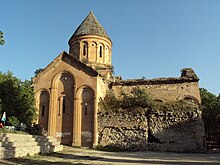| Ishkhani | |
|---|---|
 Ishkhani monastery | |
| Location | |
| Location | İşhan, Yusufeli District, Artvin Province, |
| Geographic coordinates | 40°47′08″N 41°44′49″E / 40.78565°N 41.74698°E |
Ishkani or Ishkhan, (Armenian: Իշխան, prince, Georgian: იშხანი, Turkish: Işhan) is a ruined Christian monastery in the territory of Turkey in the village of İşhan, Artvin province. The name Ishkhani derives from the word “Իշխան” (Ishkhan) which means “prince” in the Armenian language. It was one of the important spiritual centers in the Middle Ages Tayk/Tao-Klarjeti. Only the magnificent church and the adjacent chapel have survived. The earliest mention of the monastery is found in The Life of Grigol Khandzteli, a Georgian manuscript dating from the year 951, which is now kept in Jerusalem.
In this manuscript it is stated that Saba, the nephew and follower of the priest Gregory of Khandzta,[1] founded a monastery on the site of an earlier church. The first church built by catholicos Nerses III (641-661), who was native from the village of Ishkhan, and is also known as Nerses III Ishkhanetsi,[2][3][4] had a tetraconch plan (a central dome with four apses radiating to the cardinal points) and was presumably damaged during the Arab invasions of the 7th century. Five Georgian inscriptions within the church and on the southern facade indicate different restoration periods, from 917 until 1032. From the 12th to the end of the 14th century, large vestibules were added to the south, west and north facades. The monastery used to be one of the five patriarchates of Tao-Klarjeti and its church functioned as a cathedral until the 17th century. It was used as the headquarters for the Ottoman officers during the Russo-Turkish War in the 19th century, while its west arm was converted into a mosque and remained so until 1983. In 1987, the Ministry of Culture and Tourism (Turkey) registered İshkhhan as a national cultural monument and the site is now protected. In 2013, the Monastery was being renovated.[5]
- ^ Gregory of Khandzta
- ^ The Armenian History attributed to Sebeos, translated, with Notes, by R. W. Thomson, historical Commentary by J. Howard-Johnston, Assistance from T. Greenwood (Translated Texts for Historians), Vol 2, Liverpool 1999, p. 140
- ^ Catholic Online. "Nerses I-IV - Catholic Encyclopedia - Catholic Online". catholic.org. Retrieved 2015-04-10.
- ^ Adalian, R.P. (2010). Historical Dictionary of Armenia. Scarecrow Press. ISBN 9780810874503. Retrieved 2015-04-10.
- ^ "Turkey renovating Georgian church". Hürriyet Daily News. 12 April 2013. Retrieved 23 February 2021.
